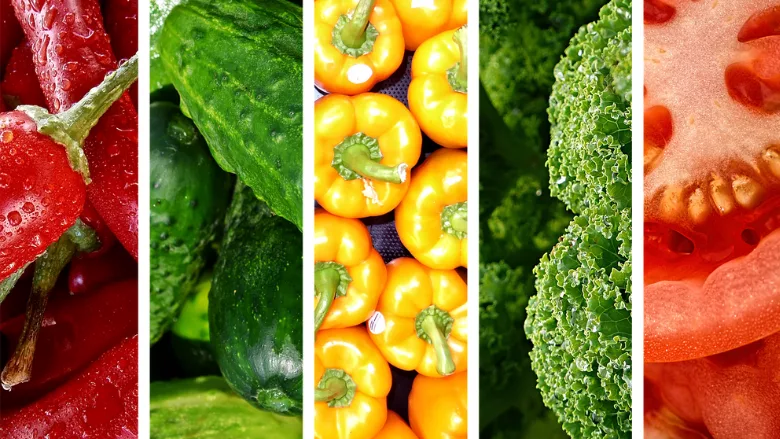Immediately Actionable Insights for Produce Safety from 2023 CPS Research Symposium

Image credit: kropekk_pl via Pixabay
The Center for Produce Safety (CPS) recently published key takeaways from its 2023 Research Symposium, which took place June 20–21 in Atlanta, Georgia. CPS highlighted scientific findings that call for immediate action, add depth to current best practices, and necessitate future investigation, regarding a variety of topics relevant to produce safety including foodborne pathogens, cleaning and sanitation, floodwater hazard mitigation, and other areas.
Findings that Call for Immediate Action
One study presented at the symposium aimed to fill knowledge gaps about the contamination patterns of and sanitation measures for Listeria monocytogenes in produce processing facilities. Findings from zone-based environmental sampling activities and whole genome sequencing (WGS) analysis suggested that Zone 3 areas should be a high priority target for cleaning and sanitation efforts. The project also underlined that by swabbing prior to cleaning and sanitation, the chance of finding L. monocytogenes increases, enabling better identification of the source contamination. The findings emphasize the importance for processing and packing operators to use “seek and destroy” strategies to control L. monocytogenes. Read a previously published in-depth overview of the study here.
The aforementioned study on L. monocytogenes contamination patterns and sanitation measures also pointed to a common observation that was seen in a different project that evaluated cleaning and sanitation practices for harvesting equipment. In both studies, it was found that the performances of cleaning and sanitation crews improve when they understand the importance of their jobs and are aware that management is overseeing their work. Training, closer adherence to protocols, and support for aggressively pursuing a “seek and destroy” approach were shown to motivate employees to work more effectively.
Another important piece of research presented at the symposium related to the survival and persistence of L. monocytogenes and Salmonella on surfaces in dry stone fruit packinghouse environments. The researchers identified and investigated critical areas for microbial risk that exist in packinghouse environments after the washing, waxing, and drying steps. Findings showed the importance of rigorously cleaning equipment and the production environment at the end of a packing season with detergents and agitation to eliminate organic residues, as well as properly sanitizing surfaces to kill L. monocytogenes and other bacteria to prevent biofilm formation. The process should also be repeated immediately before resuming operations for the season. Read a previously published in-depth overview of the study here.
Actionable insights related to the waxing of fruits were also presented at the symposium. One project found that Salmonella and L. monocytogenes survive in storage and finishing waxes, but do not grow during storage. The pathogens also undergo greater reductions on stored waxed fruit than unwaxed fruit. Therefore, it is important for fruit packers to understand their wax suppliers’ practices and controls to prevent microbial contamination during wax manufacture and subsequent handling. Equally important is proper storage and handling of source and finishing waxes to prevent-cross contamination. Care also must be taken to clean and sanitize wax application equipment to ensure they do not become vectors for cross-contamination.
Finally, immediately actionable findings were produced by a study on the potential produce safety risks brought on by flooding, which involved sampling activities at four ranches in the Salinas Valley region of California that were impacted by floods in 2023. Three key learnings emerged:
- It is important for growers to determine the risk of microbial contamination posed by floods and irrigation to their specific operations, and what mitigation measures must be put in place
- Not all floodwaters present the same risks; for example, fields flooded by tributaries or creeks yielded soil samples that were positive for Shiga toxin-producing Escherichia coli (STEC) whereas river-flooded fields did not
- Fecal coliforms may not be a good indicator for pathogens in soil; instead, generic E. coli may be a more consistent indicator for potential pathogen presence in flooded fields.
Findings that Add Depth to Current Best Practices
In its summary of the 2023 Research Symposium, CPS also called attention to projects that build on the results of earlier CPS-funded research and add depth to existing knowledge that can be used by companies to reflect upon current produce safety programs and ensure that strategies being employed are aligned with the most recent science.
A study on cleaning and sanitation practices for harvesting equipment, mentioned previously alongside the study on L. monocytogenes contamination patterns and sanitation measures, underlines the importance of continued grower/harvester outreach and education to ensure that effective, immediate, and verifiable cleaning and sanitation of equipment is performed at least daily. The project specifically pertained to cleaning/sanitation practices for harvest equipment among blueberry harvesters and packers. Only 70–75 percent of study participants reported cleaning and sanitizing harvest equipment regularly, while 3 percent never cleaned/sanitized harvest equipment and the rest of respondents reported being unaware of the need to do so. Read a previously published in-depth overview of the study here.
Looking for quick answers on food safety topics?
Try Ask FSM, our new smart AI search tool.
Ask FSM →
Next, the exploration of three different sampling models for STEC, Salmonella, and Cyclospora in leafy greens, tomatoes, and cilantro, respectively, revealed that preharvest is more powerful than finished product testing for pathogen detection. Preharvest sampling plans should be based upon hazards analysis and the types of risks present in any given field, and the ability to detect a low level of pathogens was shown to increase with the number of samples taken and the size or the total mass of the samples. Additionally, risk mapping by observation or additional rapid sampling and testing in the production environment can help identify higher-risk areas for concentrated sampling.
In another study, researchers used a number of cattle fecal material biomarkers to measure the dispersal of particles from animal feeding operations by wind, confirming that the possibility of dust particles transmitting viable E. coli O157:H7 or Salmonella over long distances to any field is dependent on many variables, and that risk assessment and the development of mitigation strategies therefore require a systems approach that account for multiple factors. This may include measuring the distance from a field to a feeding operation; developing a working relationship with local feedlot operators to understand their pathogen control measures; monitoring prevailing wind direction and speeds during crop production; tracking weather conditions that might damage plant tissues and create harborage sites for windblown pathogens; examining cleaning, sanitation, and storage protocols for harvest equipment and containers; evaluating the efficacy of windbreaks and buffer zones; investigating the vulnerabilities of open water sources used for production to windblown dust; employing more robust, risk-based raw product testing based on conditions during crop production; modifying harvest schedules, if possible, to permit pathogen die-off; and measuring particulates (e.g., fecal biomarkers, bile salts, heterotrophic bacteria, and etc.) in the air coming from the direction of the feedlot, if possible.
To help growers mitigate food safety risks posed by wild birds, one study examined the prevalence of different wild bird species in agriculture and whether they carry and transmit foodborne pathogens. The researchers found that viable Salmonella can be spread to crops by wild birds, and concluded that it is important to consider what types of birds are present in the general farm environment, as the species of bird affected the risk of their defecation on crops. Effective mitigations to reduce food safety risks from wild birds may include identifying bird species around the farm, including their density and migratory patterns; employing scare tactics (e.g., decoys, lasers, or predator sounds), using physical deterrents (e.g., netting and spikes) to discourage roosting, maintenance of natural habitats, understanding the distances between animal operations and the produce farm, and monitoring weather conditions (e.g., temperature and humidity) that might prolong Salmonella survival. Read a previously published in-depth overview of the study here.
Another project presented at the symposium aimed to describe the current state of food safety preparedness among controlled environment agriculture (CEA) producers and identify future research needs for the sector. Areas for opportunity identified by the project include food safety education at the executive level to create awareness of and begin a dialogue on key issues; research on the risk of L. monocytogenes in CEA; research on pathogen movement within CEA production; characterizing the microbial community and pathogen control on soilless substrates and growth media; the creation of standards on nutrient solution management; better awareness on the interrelatedness of equipment design, cleaning, and sanitation; the development of workforce training tools for food safety; the development of environmental monitoring programs (EMP); and creating a standardized collection of terms and definitions to foster clear communications within the. CEA can leverage existing food safety knowledge from conventional agriculture to develop effective hazards analysis and risk assessments.
In a study focused on wash water control in apple dump tanks, researchers confirmed disinfectant concentration, chemical oxygen demand (COD), and contact time as critical variables that must be monitored closely to ensure pathogen control. The researchers’ findings underscored that a “one-size-fits-all” approach to controlling wash water quality is not sufficient and that each system and product combination must be tested, operating parameters (e.g., sanitizer concentration, contact time, pH, COD, rate of make-up water addition, product load per unit time, and etc.) must be established, and microbial control must be validated and continuously verified during commercial operations.
Findings that Necessitate Monitoring for Future Investigation
Finally, the 2023 Research Symposium featured research that companies should monitor as they show future promise to improve produce safety. For example, human norovirus has been shown to be able to survive in water and on leafy greens. However, findings indicated that commonly employed water disinfection practices (e.g., 1 minute contact time with 5-20 parts per million [ppm] sodium hypochlorite or 2-3 ppm chlorine dioxide), is sufficient to control enteric viruses like human norovirus.
Additionally, one project demonstrated the ability of a prototype food-grade, spray-on antimicrobial coating for equipment surfaces that could reduce E. coli O157:H7 and L. monocytogenes by 4-log. Another tool presented at the symposium that could improve produce safety is an in-field tool to detect and track fecal contamination using DNA from a nonpathogenic, anaerobic bacteria that serves as a biomarker for fecal contamination. The technology could be combined with metadata (i.e., animal intrusion evidence, weather data, and changes in agricultural practices or inputs) to create effective mitigation strategies.
The last piece of research presented at the symposium that calls for monitoring and future investigation relates to two approaches to Cyclospora inactivation—ultraviolet (UV) light and ozone treatment. The research team demonstrated greater than 99 percent inactivation of Eimeria oocysts (used as a surrogate for Cyclospora) with multiple wavelengths of UV light. The researchers also achieved greater than 95 percent inactivation of Eimeria oocysts with 6 ppm ozone. The team also developed the first automated platform for scoring Cyclospora inactivation, which uses machine learning to detect viable oocysts with 90–95 percent accuracy.









